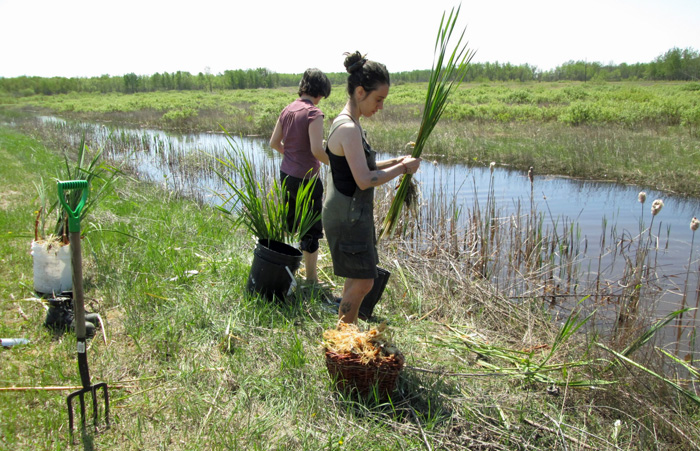Step outside and look around you. Is there a corner of your yard that’s overgrown and unruly? Are you excited to get back in the garden, while at the same time dreading all the weeding you’ll need to do? Perhaps you’re looking at your neighbour’s lawn and wishing you had lush green grass like theirs, instead of the mess of clover, plantain and dandelions at your feet. Expand your vision and you may see a slough or woodland that’s thick with burdock, cattails or hawthorn. All of these places offer huge potential for backyard foraging.
There’s an incredible array of food all around us, growing of its own accord – from roots and shoots, to mushrooms and fruits; from flours and greens to spices and teas. These are not “poverty” foods, but rich sources of flavour, nutrition and gratification. Roasted dandelion roots, plantain seeds, milkweed flowers and wild bergamot (aka pizza plant) are just a few of my favourites.
So where to start? The easiest foraging occurs in our gardens where many volunteer plants, otherwise known as weeds, take advantage of loose soil and low competition, growing in profusion. These plants are easy to identify and harvest. Once you’ve discovered these food sources, you’ll likely find some of your regular garden crops redundant. (Why put effort into growing spinach when lamb’s quarters is by far superior in both flavour and nutrient content?) By eliminating redundancy, we can focus our energy on the things that nature doesn’t provide, like potatoes and beans. Red-root pigweed, dandelions, portulaca, dock (wild sorrel) and chickweed are just a few examples of delectable garden weeds.
Of course, wild spaces also offer copious amounts of food. Take cattails, for example, which produce crispy cucumber-flavoured shoots, as well as roots, flowers, and pollen that taste like corn. The painful patch of stinging nettle residing beside your barn is probably the most nutrient dense plant around. Harvested with care, the leaves make a wonderful addition to soups, breads and desserts. And though it may be hard to believe, that blasted burdock that gets tangled in your pets’ hair is held in high regard in Japan, and even exported to Canada under the name “gobo”, for good reason – the roots are absolutely delicious when peeled and cooked in a sweet and sour broth.
As the summer progresses, we can enjoy a wide variety of berries, cherries and nuts, from saskatoons and chokecherries to acorns and hazelnuts.
When is the best time for harvesting? Simply put, follow the energy of the plants. Wherever a plant is putting its energy is the part to focus our harvesting on. Before plants go dormant for the winter, the energy and nutrients in their leaves and stems are transferred to their roots in order to fuel next year’s growth. This means the best time to harvest roots is in the fall or early spring while the leaves are still small or, in the case of dandelions, before they flower. As the plants develop, it’s time to focus our attention on above-ground parts, like leaves and shoots. As the plants flower and set seed, older leaves often become tough or bitter and it’s time to shift our attention to flower and seed harvesting.
Remember, it’s never too early to start putting things away for the winter. Our wild bounty can be preserved in the same ways our garden produce can, by drying, freezing, canning and pickling.
Laura Reeves is a botanist and wild food aficionado who loves sharing her knowledge of local plant uses. For an in-depth guide to wild foraging in Manitoba, be sure to check out her bestselling book, Laura Reeves’ Guide to Useful Plants – From Acorns to Zoom Sticks, available at local retailers. Laura also offers backyard plant walks to help you get acquainted with the tasty treasures in your own backyard.




